- Home
- Peter F. Hamilton
The Neutronium Alchemist Page 5
The Neutronium Alchemist Read online
Page 5
Ralph closed his eyes and let the briefing invade his mind, neural nanonics tabulating it into a sharply defined iconographic matrix.
Details of the Xingu continent: a sprawl of four and a half million square kilometres in the northern hemisphere, roughly diamond-shaped, with a long mountainous ridge of land extending out from its southern corner. The ridge crossed the equator; and Ombey’s broad tropical zones meant the entire continent was an ideal farming region, with the one exception of the semi-desert occupying the centre. So far only two-fifths of it was inhabited, but with a population of seventy million, it was the second-most prosperous continent after Esparta, where the capital Atherstone was situated.
After Xingu came the embassy trio, Jacob Tremarco, Savion Kerwin, and Angeline Gallagher. Their career files contained nothing exceptional, they were all regular Kulu Foreign Office staffers: loyal, boring bureaucrats. Visuals, family histories, medical reports. It was all there, and none of it particularly useful apart from the images. Ralph stored them in a neural nanonics memory cell, and spliced them with a general characteristics recognition program. He hadn’t forgotten that strange image-shifting ability the sequestrated had demonstrated back on Lalonde. The recognition program might give him a slight edge if one of them attempted a disguise, though he didn’t hold out much hope.
The most promising part of the datapackage was the series of measures Admiral Farquar and Leonard DeVille, Xingu’s Home Office minister, had implemented to quarantine the continent and trace the embassy trio. All civil traffic was being systematically shut down. Search programs were being loaded into the continent’s data cores, watching for a trail of unexplained temporary glitches in processors and power circuits.
Public-area security monitor cameras had been given the visual pattern of the trio, and police patrols were also being briefed.
Maybe they’d get lucky, Ralph thought. Lalonde was a backwards colony on the arse edge of nowhere, without any modern communications or much in the way of civil authority. But Ombey was part of the Kingdom, the society he’d sworn to defend with his life if need be. Years ago at university, when he’d discreetly been offered a commission in the agency, he’d considered Kulu a worthwhile society. The richest in the Confederation outside Edenism, it was strong economically, militarily; a technology leader. It had a judicial system which kept the average citizen safe on the streets, and was even reasonably fair by modern standards. Medical care was socialized. Most people had jobs. Admittedly, ruled by the Saldanas, it was hardly the most democratic of systems, but then short of the Edenist Consensus few democratic societies were truly representative. And there were a lot of planets which didn’t even pretend to be egalitarian. So he’d swallowed any niggling self-suspicion of radicalism, and agreed to serve his King until his death.
What he’d seen of the galaxy had only served to strengthen his conviction that he’d done the right thing in taking the oath. The Kingdom was a civilized place compared to most; its citizens were entitled to lead their lives without interference. And if that meant the ESA occasionally having to get its hands dirty, then so be it, as far as Ralph was concerned. A society worth having is worth protecting.
And thanks to its own nature, Ombey should definitely be able to cope better than Lalonde. Although the very systems which made it more able also gave the enemy a greater opportunity to spread its subversion. The virus carriers had been slow to travel on Lalonde. Here they would suffer no such restrictions.
Cathal Fitzgerald cut the flyer’s fusion drive when they were two hundred kilometres above Xingu. Gravity took over, pulling the flyer down. Its magnetic field expanded, applying subtle pressures to the tenuous gases pushing against the fuselage. Buoyant at the centre of a sparkling cushion of ions, the flyer banked to starboard and began a gentle glide-spiral down towards the spaceport below.
They were a hundred and fifty kilometres high when the flight computer datavised a priority secure signal from Roche Skark into Ralph’s neural nanonics.
“We might have a problem developing,” the ESA director told him. “A civil passenger flight from Pasto to Atherstone is having trouble with its electronic systems, nothing critical but the glitches are constant. I’d like to bring you in on the Privy Council security committee to advise.”
“Yes, sir,” Ralph acknowledged. The datavise broadened to a security level one sensenviron conference. Ralph appeared to be sitting at an oval table in a plain white bubble room with walls at an indeterminate distance.
Admiral Farquar was sitting at the head of the table, with Roche Skark and the ISA director Jannike Dermot flanking him. Ralph’s neural nanonics identified the other three people present. Next to the ISA director was Commander Deborah Unwin, head of Ombey’s Strategic Defence network; Ryle Thorne, Ombey’s national Home Office minister, was placed next to her.
Ralph found himself with Roche Skark on one side, and Leonard DeVille on the other.
“The plane is seven minutes from Atherstone,” Deborah Unwin said. “We have to make a decision.”
“What is the plane’s current status?” Ralph asked.
“The pilot was instructed to turn back to Pasto by my flight controllers as part of the quarantine procedures. And that’s when he reported his difficulties. He says he’ll be endangering the passengers if he has to fly all the way back to Pasto. And if it’s a genuine malfunction he will be.”
“We can hardly go around using our SD platforms on civil aircraft just because they have a dodgy processor,” Ryle Thorne said.
“On the contrary, sir,” Ralph said. “In this situation we have to maintain a policy of guilty until proven innocent. You cannot allow that plane to land in the capital, not under any circumstances. Not now.”
“If he has to fly back to Xingu he may well kill everyone on board,” the minister protested. “The plane could be downed in the ocean.”
“Atherstone has a high proportion of military bases in the surrounding district,” Admiral Farquar said. “If necessary the plane can simply sit on a landing pad surrounded by marines until we work out a satisfactory method of detecting if the virus is present.”
“Is the pilot using his neural nanonics to communicate with flight control?” Ralph asked.
“Yes,” Deborah said.
“Okay, then it’s a reasonable assumption that he’s not been sequestrated. If you can guarantee a landing pad can be guarded securely, I say use it. But the plane must remain sealed until we find out what’s happened to the embassy trio.”
“Good enough,” Admiral Farquar said.
“I’ll put the marines at Sapcoat base on active status as of now,” Deborah said. “That’s over a hundred kilometres from Atherstone. The plane can reach it easily enough.”
“A hundred kilometres is a safe enough distance,” Ryle Thorne said smoothly.
Ralph didn’t like the minister’s attitude; he seemed to be treating this as if it were a minor natural incident, like a hurricane or earthquake.
But then the minister had to go back to his constituents every five years and convince them he was acting in their best interests. Ordering SD platforms to fire on their fellow citizens might be hard to explain away in public relations terms. That was one of the reasons the royal Saldanas had a parliament to advise them. An insulating layer around the blame.
Elected politicians were always culpable and replaceable.
“I’d also suggest that once the plane’s landed you use an orbital sensor satellite to mount a permanent observation on it,” Ralph said. “Just in case there’s any attempt to break out. That way we can use the SD platforms as a last resort; sterilize the entire area.”
“That strikes me as somewhat excessive,” Ryle Thorne said with elaborate politeness.
“Again, no, sir. On Lalonde the enemy were able to use their electronic warfare capability to interfere with the LDC’s observation satellite from the ground; they fuzzed the images to quite a degree. I’d say this fallback option is the least we should be doing.�
�
“Ralph was brought in because of his experience in combating the virus,” Roche Skark said, smiling at the minister. “He got off Lalonde precisely because he instigated these kinds of protective measures.”
Ryle Thorne gave a short nod.
“Pity he didn’t protect us from the virus,” Jannike muttered. Except in a sensenviron context nothing was really sotto voce; all utterances were deliberate.
Ralph glanced over at her, but the computer-synthesised image of her face gave nothing away.
Chapman Adkinson was getting mighty tired of the continual stream of datavises he was receiving from flight control. Worried, too. He wasn’t dealing with civil flight control at Atherstone anymore; they’d gone off-line eight minutes ago. Military protocols were being enforced now, the whole planet’s traffic control being routed through the Royal Navy operations centre on Guyana. And they were none too sympathetic to his condition.
Esparta was rolling by below the plane, one of the lush national parks which surrounded the capital. A jungle scarred only by the occasional Roman-straight motorway and dachas belonging to the aristocracy. The ocean was five minutes behind them.
His neural nanonics were accessing the external sensors, but the visual image was only being analysed in secondary mode, mainly to back up the inertial guidance system which he no longer wholly trusted. He was concentrating on schematics of the plane’s systems. Twenty per cent of the onboard processors were suffering from random dropouts. Some had come back on-line after a few seconds, others remained dead. The diagnostic programs he ran simply couldn’t pinpoint the problem. And, even more disturbing, in the last fifteen minutes he’d been experiencing spikes and reductions in the power circuits.
That was what had made him argue with the military controllers. Processor glitches were an acceptable menace; there was so much redundancy built into the plane’s electronic architecture it could survive an almost total shutdown; but power loss was in a different hazard category altogether.
Chapman Adkinson had already decided that if they did try to force him to fly back over the ocean he was going to ditch there and then, and to hell with the penalties they’d load into his licence. The biohazard in Xingu couldn’t be that lethal, surely?
“Chapman, stand by for some updated landing coordinates,” Guyana’s flight controller datavised. “We’re diverting you.”
“Where to?” Chapman asked sceptically.
“Sapcoat base. They’re prepping a clean reception area for you. Looks like the passengers are going to have to stay on board for a while once you’re down.”
“As long as we get down.”
The coordinates came through, and Chapman fed them directly into the flight computer. Twelve minutes to Sapcoat. He could accept that. The plane banked gently to port, and began to curve away from the city which lay somewhere beyond the horizon’s black and silver heat shimmer.
It was a signal for the glitches to quadruple. Circuits began to drop out at a frightening rate. A quarter of the system’s schematics flicked to a daunting black, leaving only ghostly colourless outlines where functional hardware had been a moment before. Power to the two rear starboard compressors failed completely. He could hear the high-pitched background whine deepening as the blades slowed. The flight computer’s compensation program went primary, but too many control surfaces had shut down for it to be truly effective.
“Mayday, mayday,” Chapman datavised. Even his primary transmitter had failed. Backup processors were activated. The fuselage began to vibrate and judder, as if the plane were ploughing through a patch of choppy air.
His neural nanonics reported a stream of datavises from the passenger cabin, querying the shaking and sudden loss of in-flight entertainment processors. He called up a procedural file and shunted it into what was left of the plane’s entertainment circuits. Seatback holoscreens should be playing a placebo message about clear air turbulence and the precautions their pilot was now instigating.
“What is it?” flight control asked.
“Losing power and height. Systems failure rate increasing. Shit! I just lost the tail rudder databus.” He datavised an emergency code into the flight computer. A silvery piston slid out of the horseshoe console in front of him, a dull chrome-red pistol grip on the end. It reached his lap and rotated silently through ninety degrees. Chapman grabbed it.
Manual control. Christ, I’ve never used one outside of Aviation Authority simulations!
The datavise bandwidth to the flight computer started to shrink. He prioritized the schematic to display absolute essentials. Holographic displays on the console came alive, duplicating the information.
“Find me a flat patch of land, now, damn it!” How he was going to bring the plane down in VTOL configuration with both the starboard compressors out wasn’t something he wanted to think about. Maybe a motorway, and use it like a runway?
“Request denied.”
“What?”
“You may not land anywhere but the authorized coordinate.”
“Fuck you! We’re going to crash.”
“Sorry, Chapman, you cannot land anywhere outside Sapcoat.”
“I can’t reach Sapcoat.” His datavised control linkage to the flight computer began to fail. The pistol grip shifted slightly in his hand, and he felt the plane tilt in tandem.
Careful! he told himself. A firm pressure on the grip, and the nose began to edge back. The holographic horizon graphic showed he was still in a shallow dive. More pressure, and the descent rate slowed.
The door into the cockpit slid open. Chapman Adkinson was wired too tight to care. It was supposed to be codelocked, but the way hardware was crashing …
“Why have you altered course?”
Chapman shot a quick glance over his shoulder. The guy was dressed in a cheap suit, five years out-of-date. He wasn’t just calm, he was serene.
Incredible! He must feel the plane’s buffeting.
“Technical problem,” Chapman managed to gasp. “We’re putting down at the nearest landing pad that can handle an emergency.” The pistol grip was fighting his every movement. And now the holographic displays were wobbling. He wasn’t sure if he could trust them anymore. “Get back into your seat now, fella.”
The man simply walked up behind the pilot’s chair and slid his head over Chapman’s shoulder, peering out of the narrow curving windscreen. “Where is Atherstone?”
“Look, pal—” Pain lanced deep into his thigh. Chapman grunted roughly at the shock of it. The man’s left index finger was resting lightly on his leg, a small circle of his uniform’s trouser fabric was burning around it.
Chapman swatted at the small blue flames, eyes blinking away sudden tears. His thigh muscle was smarting abominably.
“Where is Atherstone?” the man repeated. “I have to go there.”
Chapman found his calmness more unnerving than the plane’s failure.
“Listen, I wasn’t joking when I said we had technical problems. We’re going to be lucky if we make it over this sodding jungle. Forget about Atherstone.”
“I will hurt you again, harder this time. And I will keep on hurting you until you take me to Atherstone.”
I’m being hijacked! The realization was as staggering as it was improbable. Chapman gagged at the man. “You have got to be kidding!”
“No joke, Captain. If you do not land in the capital, I will see to it you don’t land anywhere.”
“Holy Christ.”
“Atherstone. Now where is it?”
“To the west somewhere. Christ, I’m not sure where. Inertial guidance has packed up.”
A mirthless smile appeared on the man’s face. “Then head west. It is a big city. I’m confident we’ll see it from this height.”
Chapman did nothing. Then winced as the man reached past him. He put his hand on the windscreen, palm flat. Horrifyingly deep white cracks splintered outward.
“Atherstone.” It was an order.
“Okay. Just take your godd
amn hand off that.” The windscreen was artificial sapphire for God’s sake. You couldn’t crack it by leaning on it. A neural nanonics status check showed him half his synaptic augmentation had crashed, and virtually all the memory cells had shut down. But there was enough capacity for a datavise. “Code F emergency,” he shot at the flight computer. Followed by a small prayer that it hadn’t glitched completely yet.
“ISA duty officer,” came the response. “What’s happening?”
Chapman used the last of his neural nanonics’ capacity to issue a metabolic override, keeping his face perfectly composed. He must not betray the silent conversation by a twitch of emotion. “Attempted hijacking. And the plane’s falling apart around me.”
“How many hijackers?”
“Just one, I think. Can’t access the cabin cameras.”
“What does he want?”
“He says he wants to go to Atherstone.”
“What sort of weapon is he using?”
“Not sure. Nothing visible. Some kind of implant. Maybe a thermal induction field generator. He burnt my leg and damaged the windscreen.”
“Thank you. Hold please.”
Like I can do something else, Chapman thought acidly. He flicked a curious glance at the man who was still standing to one side of the chair. His face was as emotionless as Chapman’s.
The plane rocked alarmingly. Chapman tried to damp it down by swaying the pistol grip to compensate for the erratic motion. On a plane with fully responsive control surfaces it might have worked, here it just slewed the tail around. He noticed the nose had dropped a couple of degrees again.
“If you don’t mind me asking, what’s so bloody important in Atherstone that you’ve got to pull this crazy stunt?”
“People,” the man said blandly.
Some of the man’s calmness was infiltrating Chapman’s own mind. He pulled back on the pistol grip, easing the nose up until they were level again.
Nothing to it. At least there were no more systems dropping out, the malfunctions appeared to have plateaued. But landing would be a bitch.

 A Night Without Stars
A Night Without Stars If at First . . .
If at First . . .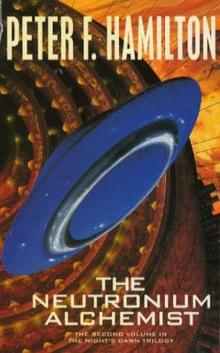 The Neutronium Alchemist
The Neutronium Alchemist Great North Road
Great North Road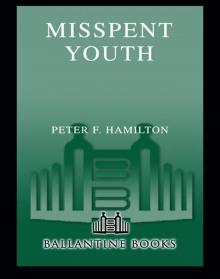 Misspent Youth
Misspent Youth Pandora's Star
Pandora's Star The Evolutionary Void
The Evolutionary Void The Dreaming Void
The Dreaming Void Mindstar Rising
Mindstar Rising The Temporal Void
The Temporal Void A Quantum Murder
A Quantum Murder The Hunting of the Princes
The Hunting of the Princes Salvation Lost
Salvation Lost The Dreaming
The Dreaming Salvation
Salvation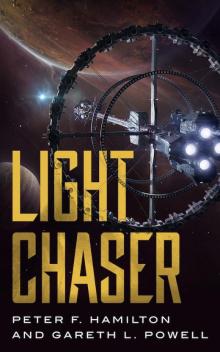 Light Chaser
Light Chaser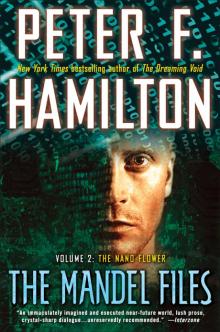 The Mandel Files, Volume 2: The Nano Flower
The Mandel Files, Volume 2: The Nano Flower![The Saints of Salvation [British Ed.] Read online](http://i1.bookreadfree.com/22/the_saints_of_salvation_british_ed__preview.jpg) The Saints of Salvation [British Ed.]
The Saints of Salvation [British Ed.] Manhattan in Reverse
Manhattan in Reverse The Secret Throne
The Secret Throne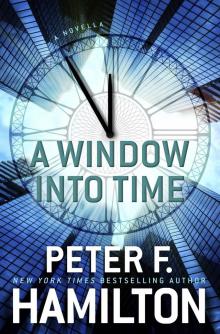 A Window Into Time
A Window Into Time A Second Chance at Eden
A Second Chance at Eden The Nano Flower
The Nano Flower The Confederation Handbook
The Confederation Handbook The Naked God
The Naked God The Saints of Salvation
The Saints of Salvation The Void Trilogy 3-Book Bundle
The Void Trilogy 3-Book Bundle The Abyss Beyond Dreams
The Abyss Beyond Dreams A Voyage Through Air
A Voyage Through Air Judas Unchained
Judas Unchained The Commonwealth Saga 2-Book Bundle
The Commonwealth Saga 2-Book Bundle The Naked God - Flight nd-5
The Naked God - Flight nd-5 Night Without Stars (Chronicle of the Fallers Book 2)
Night Without Stars (Chronicle of the Fallers Book 2) Neutronium Alchemist - Conflict nd-4
Neutronium Alchemist - Conflict nd-4 Reality Dysfunction - Expansion nd-2
Reality Dysfunction - Expansion nd-2 Now We Are Ten: Celebrating the First Ten Years of NewCon Press
Now We Are Ten: Celebrating the First Ten Years of NewCon Press Neutronium Alchemist - Consolidation nd-3
Neutronium Alchemist - Consolidation nd-3 If at First . . . (Short Story)
If at First . . . (Short Story) A Second Chance at Eden nd-7
A Second Chance at Eden nd-7 Judas Unchained cs-2
Judas Unchained cs-2 The Mandel Files, Volume 1
The Mandel Files, Volume 1 Reality Dysfunction — Emergence nd-1
Reality Dysfunction — Emergence nd-1 The Temporal Void (ARC)
The Temporal Void (ARC) The Mandel Files
The Mandel Files Fallen Fragon
Fallen Fragon Misspent Youth (commonwealth saga)
Misspent Youth (commonwealth saga) If at First...
If at First... Best of British Science Fiction 2016
Best of British Science Fiction 2016 The Mandel Files, Volume 2
The Mandel Files, Volume 2 The Naked God - Faith nd-6
The Naked God - Faith nd-6 The Night's Dawn Trilogy
The Night's Dawn Trilogy Pandora's Star cs-2
Pandora's Star cs-2 A Window into Time (Novella)
A Window into Time (Novella)